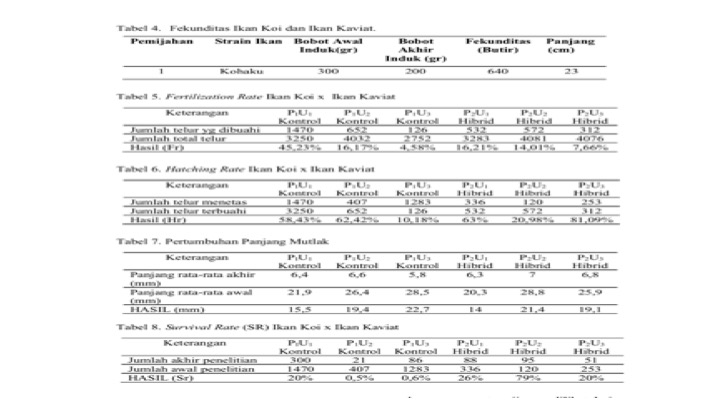Hibridization of koi (Cyprinus rubrofuscus) and tinfoil barb (Barbonymus schwanenfeldii) by artificial breeding
DOI:
https://doi.org/10.46252/jsai-fpik-unipa.2025.Vol.9.No.1.506Keywords:
fecundity, fertilization rate, hatching rate, hybridization, survival rateAbstract
Fish hybridization is the process of crossing two different fish species to produce offspring that have characteristics of both parents. The main purpose of hybridization is usually to combine superior traits from both species, such as faster growth, disease resistance, or improved meat quality. The experimental design used in this study was a completely randomized design (CRD) with 2 treatments and each treatment consisted of 3 replicates. The treatments were as follows: P1 = Koi X Koi Fish Hatchery (control), P2 = Koi X Kaviat Fish Hatchery. The results showed that the pH value in borehole water quality was 7.89 with Kohaku broodstock producing fecundity of 640 eggs, obtained an average Fertilization Rate (FR) of 17.29% resulting from the average of each egg sample calculation. The highest number of fertilized eggs was found in the PIU1 treatment which was 1470 eggs and the average Hatching Rate (HR) was 49.35%. The conclusion of this study is that hybridization between Koi and Kaviat fish can produce good potential performance based on water quality that can be maintained well with test parameters seen from fecundity, FR, HR, Length Growth, and good Survival Rate (SR). Superior fecundity and quality in the hybridization process between koi and caviat fish can occur well if several environmental factors such as temperature and pH are still on an optimal scale.
Downloads
References
Alim, Junianto, R.S. (2014). Pengaruh Lanjut Suhu pada Penetasan Telur dan Kelangsungan Hidup Benih Ikan Baung (Hemibagrus nemurus). Prosiding Seminar Nasional Lahan Suboptimal, pp. 301–308.
Arunde, E., Sinjal, H. J., dan Monijung, R. D. (2016). Pengaruh penggunaan substrat yang berbeda terhadap daya tetas telur dan sintasan hidup larva ikan lele sangkuriang (Clarias sp). e-Journal Budidaya Perairan, 4(1).
Augusta, T.S., Setyani, D., Riyanti, F. (2020). Proses Pemijahan Semi Buatan dengan Teknik 113 Stripping (Pengurutan) pada Ikan Betok (Anabas testudineus). Jurnal Ilmu Hewani Tropika, 9(1), pp. 29–34.
Ayer Y, Mudeng J, Sinjal H. (2015). Daya Tetas Telur dan Sintasan Lara dari Hasil Penambahan Madu pada Bahan Pengencer Sperma Ikan Nila (Oreochromis niloticus). Jurnal Budidaya Perairan, 3 (1): 149 – 153.
Fariedah F, Inalya , Rani, Ayunin, Evi T. (2018). Penggunaan Tanah Liat untuk Keberhasilan Pemijahan ikan Patin (Pangasianodon hypophthalmus). Jurnal Ilmiah Perikanan dan Kelautan, 10(2): 91-94.
Fauzan, A. L., Budiardi, T., Effendi, I., Diatin, I., Hadiroseyani, Y., & Dewi, N. N. (2024). Analisis Produksi dan Distribusi Pembenihan Ikan Koi (Cyprinus Carpio) berdasarkan Sebaran Kualitas Seleksi di Omah Koi Farm Indonesia. Berita Biologi, 23(1), 103-114.
Habibi, Sukendi, Aryani, N. (2013). Kematangan Gonad Ikan Sepat Mutiara (Trichogaster leeri Blkr) dengan Pemberian Pakan yang Berbeda. Jurnal Akuakultur Rawa Indonesia, 1(2), pp. 127–134.
Ishaqi, A.M.A. dan P.D.W. Sari. (2019). Pemijahan Ikan Koi (Cyprinus Carpio) dengan Metode Semi Buatan: Pengamatan Nilai Fekunditas, Derajat Pembuahan Telur dan Daya Tetas Telur. Jurnal Perikanan dan Kelautan. 9 (2) : 216 – 224.
Ismail dan A. Khumaidi. (2016). Teknik Pembenihan Ikan Mas (Cyprinus carpio, L) di Balai Benih Ikan (BBI) Tenggarang Bondowoso. Samakia: Jurnal Ilmu Perikanan. 7 (1) : 27-37.
Larasati, S., F. Basuki, dan T. Yuniarti. (2017). Pengaruh Jus Nanas dengan Konsentrasi Berbeda Terhadap Derajat Pembuahan dan Penetasan Telur Ikan Patin (Pangasius pangasius). Journal of Aquaculture Management and Technology. 6 (4): 218-225.
Masyal, M. G., Muhammad Rheno Arifat, Firli Aulia Rohmah, Bagus Susilo, Putri Berlianita Sudarto, Irfan Zidni. (2024). Potensi Hibridisasi Guna Mengakselerasi Pertumbuhan Ikan Gabus Channa Striatamenggunakan Metode Pemijahan Buatan. J. of Aquac. Environment Vol 7 (1) 50-53,
Sumantadinata & Y. Hadiroseyani. (2024). Potensi Hibridisasi Guna Mengakselerasi Pertumbuhan Ikan Gabus (Channa Striata) menggunakan Metode Pemijahan Buatan. J. of Aquac. Environment Vol 7 (1) 50-53
Sumino, S., Mude, H., Alam, S. S., dan Dini, D. (2017). Protected, prohibited, and invasive fish diversity and distribution in Ranau Lake of West Lampung District. AQUASAINS, 6(1), 573-578.
Tarigan,N.& Firat Meiyasa. (2018). Efektivitas Bakteri Probiotik dalam Pakan terhadap Laju Pertumbuhan dan Efesiensi Pemanfaatan Pakan Ikan Mas (Cyprinus carpio). Jurnal Perikanan Universitas Gadjah Mada 21(2): 85-92
Muchlisin, Z.A., A.A. Arisa, A.A. Muhammadar, N. Fadli, I.I Arisa dan M.N. SitiAzizah. 2016. Growth performance and feed utilization of keureling (Tor tambra) fingerlings fed a formulated diet with different doses of vitamin E (alpha-tocopherol). Archives of Polish Fisheries, 23: 47–52.

Downloads
Published
How to Cite
Issue
Section
License
Copyright (c) 2025 Abian Surya Nasita, Rita Rostika, Gatot Hari Priowirjanto, Leonardo Davinci

This work is licensed under a Creative Commons Attribution-ShareAlike 4.0 International License.


















